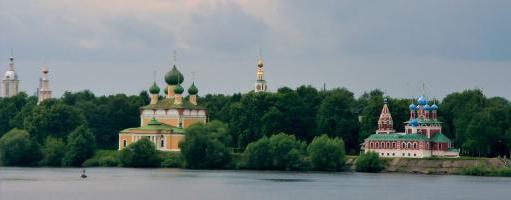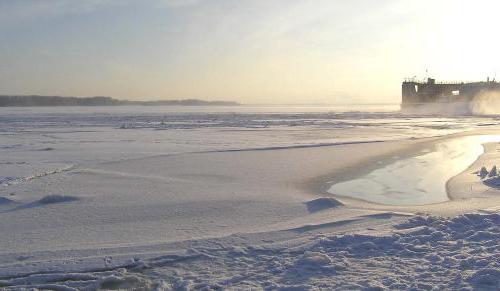Volga: geographical location. Description of the Volga River
A great river, carrying its waters from the Valdaiup to the Caspian Sea, one of the largest navigable arteries of our country is the Volga. Geographical position has provided it with a significant role in the development of trade and the formation of large cities of the Slavic tribes. The Volga is the largest river in Europe. Even today it remains an important source of fresh water and electricity, a transport main, and also draws to its shores a large number of tourists and tourists. Where is the Volga River and what are its features? This will be discussed below.
Volga: geographical location
The river adorns the European part of ourcountries. A small branch of the main channel flows through the territory of Kazakhstan. The source of the Volga is located on the Valdai Upland (229 meters above sea level). As it is commonly believed, a mighty river begins near the village of Volgoverkhovye in the Tver region. The Volga basin occupies about a third of the European territory of Russia. It extends from the Valdai and Central Russian Uplands up to the Urals.
The Volga is considered to be the largest river in the world, notflowing into the ocean. Its waters it carries to the Caspian Sea, to the basin of which it belongs. The length of the river is 3530 km, the total fall is 256 m. The Volga basin covers an area of over one million square kilometers.
The Great River is divided into three parts: the upper (from the source to the mouth of the Oka), the middle (from the mouth of the Oka to the confluence of the Kama), the lower one (from the mouth of the Kama to the Caspian Sea).
Source

The river originates from the key flowing from thea swamp near the village of Volgoverkhovye. Nearby built a temple. The very source of the Volga lies under the floor of a small wooden chapel on stilts. It has a special window through which it is allowed to scoop up and drink water.
Approximately three kilometers from the source of the Volgaflows alternately into two lakes: first to the Maly Verkhit, and then to the Great Verkhit. Further its path lies through the Upper Volga Reservoir. The first large lake that belongs to it is Sturgeon. The Volga invades its waters with great force, rapidly, without intermixing, overcomes them. They say that in sunny weather you can see how the river flows through the lake.
Upper Volga

Before the creation of reservoirs, the length of the river was larger and3690 km. The first dam in the course of the river is located after the Upper Volga lakes (Sterzh, Vselug, Peno, Volga). It was built in 1843. There are several reservoirs on the Upper Volga today: Ivankovskoe (also called the Moscow Sea, it includes a hydroelectric power station near Dubna), Uglich, Rybinsk, Gorkovskoye (located near Gorodets, above Nizhny Novgorod).
The first major settlement from the source of the river -Rzhev. On the Upper Volga there are such ancient cities as Kostroma, Tver, Uglich and Yaroslavl. It flows through a picturesque area, then spreading widely, then tapering between steep banks.
The main tributaries of the river on this segment are: Selizharovka, Darkness, Kotorosl, Tvertsa, Mologa, Sheksna, Unzha.
Average Volga
After the confluence of the Oka river flows at the right edge of the Volga Upland. Here it becomes noticeably more full-flowing. The right bank of the Volga is high, while the left bank is low.
The town of Cheboksary has a hydroelectric power station with a dam, above which there is a reservoir.
The main tributaries of the river on this segment are Oka, Sura, Vetluga, Sviyaga.
The Lower Volga

Its full power and strength the river finds afterthe confluence of Kama. On this stretch it flows along the Volga Upland. Bending around the Zhiguli Mountains, the Volga forms the Samara bow. Somewhat higher is the Kuibyshev Reservoir (adjacent to it is the Zhigulevskaya HPP). Nearby to Balakovo on the river is the Saratov Hydroelectric Power Station. In the Volgograd region, the river approaches Don. A little above the city from her separated left sleeve, Akhtuba. Its length is 537 km. Between the river and its sleeve is the so-called Volga-Akhtuba floodplain, consisting of a large number of ducts.
Not far from Volgograd, on the section of the river between the city and the beginning of Akhtuba there is the Volzhskaya HPP and the Volgograd Reservoir.
The tributaries on this sections of the river are rather small. They are Sok, Samara, Big Irgiz, Yerslan.
The mouth of the Volga

In the area of rapprochement with the Don, the river turns andfurther flows to the southeast up to the confluence of the Caspian Sea. In the place where Akhtuba separates from the main channel, the Volga delta begins. It covers an area of about 19 thousand square kilometers. Delta consists of 500 sleeves. The largest of them are Akhtuba, Bakhtemir, Kamyzyak, Old Volga, Bolda, Buzan. The second sleeve of the named ones is constantly maintained suitable for navigation and forms the Volga-Caspian canal. Kigach, which is also included in the number of sleeves of the great river, crosses the territory of Kazakhstan.
The Volga Delta is considered to be the largest in Europe. Throughout history, it has changed its position and occupied the area. Delta of the modern type was formed around the 3rd century AD, when the old riverbed could not cope with the increased volume of water. Over the past 130 years, the level of the Caspian Sea is declining. As a result, over this period, the area of the delta has increased approximately 9-fold.
At the mouth of the Volga is the last city on this river - Astrakhan. It is located on eleven islands in the upper part of the delta.

Power and mode
The Volga River, whose geographical locationconsidered above, before the construction of reservoirs was characterized by significant fluctuations in the level (below the mouth of the Kama they reached 17 m). Today there are no such serious changes and spills.
Most of the supply of the river falls on the snowwater (up to 60%). A significant role in this process is also played by rain (10%) and ground (30%) "income". During the year the Volga passes several successive transformations. In spring (April to June) this is high water. In summer and winter, the level in the river is markedly reduced. Autumn (usually in October) rains occur.

In the hottest months, the temperature of the water in the riverreaches 25º. The Volga freezes on the upper and middle sections, usually in November, in the lower part - not earlier than December. The river is freed from ice first of all in Astrakhan (in March). Upper Volga, as well as a site below Kamyshin, is opened in the first half of April. The rest of the river comes out of the winter torpor in the middle of this month.
Natural resources
The Volga on the map occupies a vast territory. It flows through the forest, forest-steppe zone and steppe. The river from ancient times is famous for its fish riches. Here live bream, roach, sterlet, carp, catfish, pike. Unfortunately, the construction of reservoirs and the contamination of water does not contribute to the preservation of all this diversity. A reserve has been created in the Volga delta. In its territory since 1919, under the protection of the state are unique plants and animals. Among them, lotus, sturgeon, pelicans, flamingos.
Volga (geographical position, featuresnutrition, unique flora and fauna) is well studied today. Together with the understanding of the changes that occur with the river throughout its existence, there comes an awareness of the problems associated with them. Today, the great Russian river urgently needs to protect its wealth. Fortunately, an increasing number of people are beginning to realize the danger of environmental problems. It can be hoped, therefore, that the unique nature and beauty of the Volga shores will persist for many centuries.
</ p>




